
Diving Eleuthera Island in the Bahamas.
(photo - © L.nasus)
This guide relates my experience travelling ‘freestyle’ from the UK, rather than booking a packaged holiday.
British Airways fly direct to Nassau from Heathrow and Virgin Atlantic fly direct from Gatwick. Indirect flights from the UK can be cheaper but sometimes require more than one stopover/plane change (even one stopover/plane change adds hours to the journey and increases the risk of luggage being misdirected).
There are flights direct to North Eleuthera Airport from Miami and Fort Lauderdale.
Nassau International Airport on New Providence Island is small and friendly, unless you are travelling during peak holiday periods, you may well be through passport control, baggage reclaim and customs in less than fifteen minutes.
The British Airways direct flight from Heathrow on a Saturday; gets you into Nassau at 15:00hrs, too late to catch the ferry to Eleuthera or to get down to Stuart Cove's Dive Centre, for a dive; on the day you arrive.
The taxi ride (7 miles) from the airport into the centre of the Bahamian capital takes approximately 25 minutes.
Ask the driver to take the coastal road, it takes slightly longer but the ocean views are much better than the vista on the direct route.
Expect to pay approx US$23 for this taxi journey however you may wish to tip a bit extra and ask the driver to turn up early the following morning; to take you to Potters Quay for the ferry to Spanish Wells or Harbour Island. (US$ and Bahamian$ are interchangeable and you may receive change in either).
Local taxi drivers think the ‘O’ in 07:00hrs stands for "Oh my God, that’s early!" as did the hotel staff ie. Too early for breakfast.
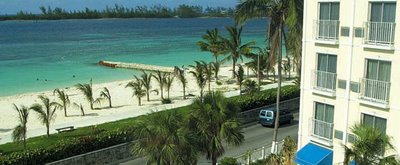
To avoid spending an arm and a leg on a fancy hotel for one night; the Nassau Palm Resort on Bay Street, opposite Junkanoo Beach is fairly central (if the taxi driver doesn’t recognise the name Nassau Palm Resort, say it used to be the Holiday Inn). At US$75 per room for double occupancy with additional 3rd and 4th persons at US$10 per head per night in February, it is cheap and cheerful, if rather ‘well used’.
This room tariff does not include 12% tax or US$9.75 per head for ‘maid service’.
I do not regard what you can see from the access landing and door as a room's 'sea view', so check if they intend to charge you extra for this!
The hotel has a bar and restaurant, but we didn’t try out the restaurant, If you like to play pool, do some shopping in town and ask for a load of quarters in your change. The hotel doesn’t keep much change in coins and the bar’s pool table takes four quarters. All the other games machines take tokens, go figure.
The centre of Nassau is more touristy than a very touristy thing. The shops are gaudy, the casinos and hotels are kitsch, restaurant food and bottled beer expensive.
There are lots of jewelry shops but if you want to buy inexpensive, genuine bling, visit Sri Lanka instead.
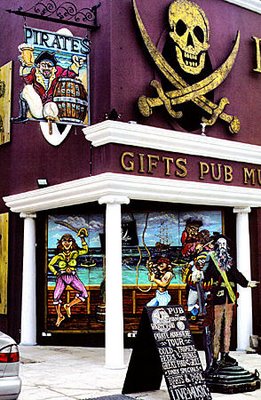
(photo - © J. Steinhart)
Apart from drinks with a meal, there are few bars in Nassau. The Pirate Bar next to the Pirate Museum was the only one we located. Do not waste money, paying extra for imported beer. Kalik the local Bahamian beer is very drinkable (proceed with caution, the Gold version is 7% rather than the regular 5%).
If you are travelling in a group I would suggest visiting one of the liquor stores and buying enough Kalik or vodka / rum and fruit punch to organise a room party, it is considerably less expensive (US$9 for a six pack of Kalik).
We ate at a ‘locals’ restaurant but the food wasn’t particularly good or particularly cheap; so no name check.
Conch is on every menu but is also a heavily over fished species. Consider carefully before ordering it. The only truly sustainable source of conch currently, is the Caicos Conch Farm in the Turks and Caicos Islands, who are licensed by CITES.
Surprisingly, Turtle is also on some menus, despite all turtle species being endangered. Needless to say do not order it or purchase any souvenirs made from Turtles.
If you enjoy pleasant evenings out then be aware, the Bahamas are not ’bitey’ free.
The local mosquitos will politely leave you alone if you use a little bug repellent, pale coloured, long sleeved tops and lightweight trousers.
The ‘no-see-ums’ are another matter altogether. Mandatory use of heavy duty bug repellent, is required to keep these voracious critters at bay!
Note - We were on a very tight schedule on this trip and consequently did not get the opportunity, but if you enjoy diving with sharks; I would strongly recommend scheduling an entire day, to go down to Stuart Cove’s world famous Dive Centre on the coast, south of Nassau. Remember to take an underwater camera!!! –
http://www.dive-bahamas.com/pages/diving/shark-adventure.html
After a relaxing evening with friends and a good nights sleep….its 06:45!..We are supposed to be on holiday!
Time to get up and get organised for the morning ferry.
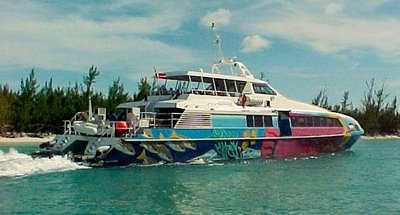
The mv. Bo Hengy is a 177 seater catamaran, which will get you to Spanish Wells in an hour and a half or Dunmore Town, Harbour Island in two hours and fifteen minutes. It is the only ferry and it only makes the voyage once per day; we had been warned that it always leaves on time, at 08:00.
You can book online (return tickets cost US$110 per person) but you still have to collect your paperwork at the ticket office –
http://www.bahamasferries.com/index.asp
Note - If you are not on the quayside, with your ticket in hand by 07:30 (ferry ticket office closes at 07:30) then you are going to be spending another 24 hours in Nassau or spending a lot of money on a local air taxi!
An 06:45 start, means the initial ‘hot’ water for the shower has had time to cool down in the pipes overnight but it does wake you up in a hurry.
The taxi ride down to the dock takes approx. 10 minutes and US$15,
A selection of breakfast snacks are available on the ferry (If like us, you have a weakness for Jamaica Patties, you are going to be particularly happy).
Spanish Wells, Russell Island and Harbour Island are classed as part of the larger Eleuthra Island (160km long but only 5km across at its widest point)

(photo - © L.Badham)
We stayed in a self catering house - Atlantic Ocean at the bottom of the garden and the Caribbean three minutes walk from the front door. - in a secluded corner of undeveloped Russell Island, which is joined to Spanish Wells by a narrow bridge. The house slept eight and cost US$200 per day plus a one off charge of US$100 for cleaning at the end of the stay.
Note - If you are arriving on a Sunday for a self catering holiday in Spanish Wells or on Russell Island, the shops will be shut. So plan to eat out and check restaurant ‘early closing on Sunday’ times.
Spanish Wells and Russell Island are very picturesque. Brightly painted, clapboard houses and long, almost empty, white sand beaches. The large bay to the right of the bridge crossing to Russell Island is very shallow and perfect for kids.

(photo - © J. Larter)
If you are not staying close to the harbour in Spanish Wells and need to get around, then Golf Carts are probably the best option. Abner Pinder’s two seater carts cost a flat US$250 for a week, four seater carts are US$275. Abners’s is just across the quay from where the mv. Bo Hengy docks in Spanish Wells. Be aware, you are liable for any damage caused to the cart, yourself or others and their property, by the cart. Check with the rental supplier that taking your cart along the less than perfect road on Russell Island is OK (this road is scheduled to be resurfaced at some point). Also check that all the tyres are adequately pumped up to avoid punctures! Hire should include a full tank of fuel (you do not have to fill up before returning the cart) this should be adequate for a week.
Take the main road out to the bridge connecting Russell Island and you will see virtually all the shops and services available on Spanish Wells (the only buildings on Russell Island are residential).
This is not a destination for 24 hour party people. Spanish Wells and Russell Island are ‘dry’. Non-teetotalers will be relieved to hear there is no ban on the consumption of alcohol, it is simply not for sale. The nearest liquor store is on nearby Eleuthera (20 minute round trip, the store is on the quay) US$5 each way per head.
Note - On small government ferries linking the local islands, large groups can normally negotiate a discount on the $5 per head charge, speak to the captain.
Monday was sunny but so windy that surface swell precluded diving (cold fronts moving in from the West, can cause strong winds in the Bahamas during February).
A foiled attempt to arrange some offshore diving with Tiger sharks through a captain from Spanish Wells, meant no diving on Tuesday.
Unless you have contacts on Spanish Wells, the nearest official scuba diving operation is Valentines Dive Centre on Harbour Island -
http://www.valentinesdive.com/index.html
The best way to get to Valentines from Spanish Wells is to get the local government ferry (US$5) to Eleuthera, then a taxi from the quay (approx US$25) across the island north of Lower Bogue, to the east coast and get the local government ferry (US$5) to Harbour Island.
It is possible to travel round the Devils Backbone reef from Spanish Wells to Harbour Island on the mv. Bo Hengy. However the trip is only available once per day, will get you to Harbour Island too late to dive in the morning and you risk missing the return journey, if you do two dives in the afternoon!
For early settlers, Dunmore Town on Harbour Island, was the capital of the Bahamas. It is built in the old colonial style and there are craft shops and several good restaurants and bars (including the one at Valentines Marina) so you may wish to linger after a days diving. Chat to your taxi driver on the journey over, you should be able to arrange an evening pick up and most importantly a seat on ‘Night Rider’, back across the channel from Eleuthera to Spanish Wells. This appropriately named ferry runs…. most of the night!
Valentines provide a professional, friendly, ‘can do’ dive service.
A two dive pack is US$75, which includes tanks and weights.
Valentines boats are a remodelled version of the local game fishing boats with a half cabin, inboard engines and large flying bridge. They are spacious, carry emergency oxygen, have a camera rinse tank and bench seating with tank clips. The water level, dive platform at the stern has a large ladder; so entry and exit are a piece of cake.
Note – In addition to Valentines’ regular guided dives and PADI training facilities; they will hire out tanks to qualified divers for US$12 per filled tank, per 24 hrs. You will need to sign a credit card slip, provide a contact telephone number and have the name of your charter boat and its skipper in order to rent a tank (to charter a boat privately, will cost approx. US$500 for half a day and approx. US$750 for a full day).
Since February is a quiet time of year for tourists, there were only two other divers on the boat when our group went out.
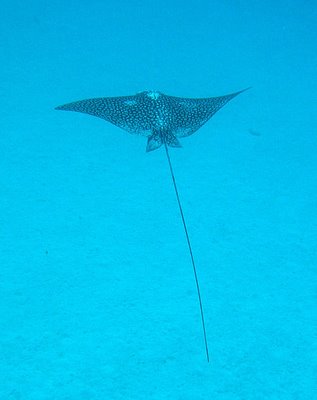
(photo courtesy of Jan Derk)
Potatoes and Onions Wreck.
Depth – approx.10m.
The Vanaheim was an 86 foot coastal freighter carrying a cargo of potatoes and onions. She ran into Devil's Backbone during a storm in February, 1969 and the force of the sea pushed her over the barrier reef.
The boat moors up in a sandy area to avoid damage to the reef. Descend to approx. 4m and swim over a ridge to get to the wreck. There are lots of soft corals on the ridge. Due to the proximity of the surface as you pass over the ridge, good buoyancy control is important. There is a certain amount of surge on the ridge. In order to conserve air, hold your position into the surge and fin fast when it sucks back (it gets so shallow at one point, its slightly surprising Valentines’ don’t opt to snorkel over the ridge from the boat and descend once on the other side). The wreck was named after its cargo, which has long since disappeared but a considerable jumble of steel plating and a couple of huge boilers remain. The boilers are large enough for a comfortable swim through and offer a good photo opportunity. Beyond the wreck there are a number of channels leading through the reef. A large eagle ray hangs out in this area and is apt to appear when you least expect it. We did see it but it was feeling bashful and did not make any close passes. Keep an eye out for barracuda here as well.
Viz. Approx.15 to 20 metres.
Tunnel Reef.
Depth – approx.10m.
Dive boat again picks a sandy patch for mooring to protect the reef.
A lot of the reef around Eleuthra is rock rather than hard coral and it is very porous, which has led to a lot of erosion. This particular site is unusual in that it allows you to go marine ‘pot holing’ without the need for specialist cave dive training. The rock is bare so you are not damaging marine life in the swim-throughs. You are always close to an escape route to the surface and you can always see the light.
That said, our dive guide made Keith Richards look fat and I did wind up with a certain amount of sand in my BCD from a couple of particularly snug ‘letterbox’ style gaps. I was considerably relieved that no electric rays had decided to snooze though the daylight hours in that particular area of substrate. I am not a massive fan of this type of diving but it was an interesting experience and as cavern diving ‘lite’; a good introduction for those who have not tried semi enclosed environment diving before, but judge your wet suit size to reef gap ratio with honesty, you do not want to get stuck!
Keep an eye out for tiny, iridescent, cuttlefish and schools of large Bermuda Chub.
Viz. approx 15 to 20 metres
The only gripe about the diving, was one that comes up unfortunately often, in many different countries. Experienced divers can squeeze an hour out of a standard tank of air, more on shallow dives. It is therefore extremely frustrating,, that many dive guides insist all of the divers in their group surface at the same time, if novice divers need to surface after only 35 to 40 minutes.
It should not be necessary to haggle for those buddy pairs with plenty of air left, to bimble about the reef, next to the boat, for another 20 minutes.
Over two dives, that is 40 minutes of dive time that an experienced diver has paid for, but been expected to give up. In novice terms, that is one complete dive lost!
Sorry novice divers, that why some grizzeled, old sea dogs go rather quiet, if they discover nobody else on the boat has more than twenty dives logged.
Thursday was another very windy day, so no diving.
Friday dawned calm and sunny. Our final opportunity to dive, respecting the 'no diving for 24 hours before flying' rule.
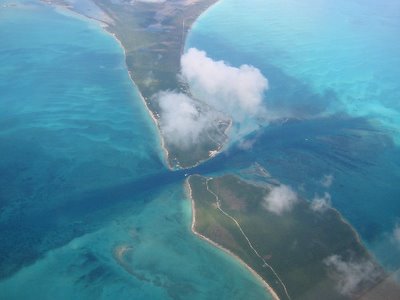
Current Cut is regarded by many, as one of the top ten drift dives in the world.
Valentines need to have six divers signed up for this dive, before they will go to the site and it costs US$135 per head. This is partly because it is the furthest site from Harbour Island that they visit and partly because of the nature of the dive site - you will get three or four dives. The good news, if you are staying in Spanish Wells is that it is your nearest site and Valentines’ boat will pick you up and drop you back at the quay (be at the dock for 10:00hrs, sharp).
Current Cut
Depth - approx. 18m, mostly 15m or less.
Current Cut is a narrow, shallow gap between North Eleuthera and Current Island and the tide whips through this channel, two and a half hours either side of high or low water at up to 10 knots! There is some low lying soft coral but this site is about adrenaline and the chance to see large pelagic species enjoying the roaring current.
Caution - there are some very large, though relatively shallow holes in the seabed in some places, which if the current is going fast enough can produce a ‘washing machine’ effect. Even when the current is not at full throttle, these holes can entail dropping and rising approx 4 to five metres in a couple of seconds. Try to skirt round the edge, but close enough to check out any wildlife taking a rest, out of the main current.
The boat does not drop anchor. Make sure all your equipment is safely tethered in close to your body. Divers line up on the dive platform at the rear of the boat with NO air in your BCD. Everyone must have an SMB for the end of the dive (Valentines have loan units, if you do not own an SMB).
When the guide says GO! You enter and descend immediately!
Keep a close eye on your dive buddy, it is very easy to get separated at this point, particularly as the viz. can be a bit murky.
This dive is timed (to avoid divers being swept too far out to sea). Exactly 15 minutes after you descend, you start your ascent and inflate your surface marker buoy as soon as you reach the surface.
There may be hundreds of metres between surfacing groups of dive buddies who descended at the same time; depending on which route and depth they took through the Cut. Deeper is slightly slower but means dodging the seabed as it races towards you.
The sea floor here is distinctly uneven, regardless of holes, breathe fast and light; don’t worry about air, you will have loads left when you surface (We used the same tanks for two dives, still had plenty, 110+ bar) but being whisked 4 metres upwards while concentrating on something else, is not a good idea!
Ever had that dream where you can fly? This dive site is that dream made real!
We dived the site four times, with the boat moving the entry drop point across the Cut from right to left so that the dive was different each time.
First dive, the speed of the current left us awe struck and a very large and curious eagle ray came along for the ride.
Second dive, we were slightly more acclimatised to the current but strangely saw very few fish. Lots of experimenting with body positioning and streamlining, to go up or down and faster or slower.
Third Dive, getting used to the current when an ENORMOUS barracuda turned up.
I have heard tales about monster barracuda before and always dismissed them as exaggerations. I mean, I have seen big barracuda underwater, right? No, this fish was BIG! Explains why all the fish had scarpered on the last dive.
If you dive this site, keep a look out for ‘Big Jo’, Valentines nickname for this behemoth.
Fourth Dive, the site had saved the best until last. There were very large eagle rays all over the place for almost the entire dive. Sadly, we didn’t see the Hammerhead shark the other group saw, but this particular trip just wasn’t doing sharks for us; sometimes life’s like that.
Viz. on all dives approx 10 to12 metres
Normally a dive trip with only two days diving and no sharks would have been a deep disappointment but Current Cut made up for all that.
The mv. Bo Hengy leaves Spanish Wells for Nassau at 16:35 on Saturday, so no early morning rush. We arrived back in Nassau at 18:15 with plenty of time to catch our flight home at 21:45.
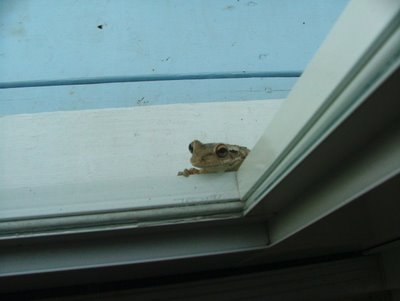
(photo - © J.Larter)
Note – The tap water looks and smells ok but bottled water is what the locals drink.
Note - Valentines Dive Centre accepts credit cards but many local shops do not. There is an international ATM on Spanish Wells but as we all know, machines can be out of order just when you need them most. Make sure you have sufficient 'green'!
Note – The nearest recompression chamber facilities are in Nassau.
Note - I heartily recommend ‘The Dive Sites of….’ range of books. Written by authors who know their dive locality well; these books are packed with useful details on international dive destinations, in depth comments on individual dive sites and graced with stunning underwater photography.
Sadly, some titles in this series may be out of print, check Amazon for 'used' deals, many of these books are 'as new'.
My only small gripe is that they could be revised more often to keep contact details up to date. Still, you can’t have everything.
‘The Dive Sites of the Bahamas’ by Lawson Wood.
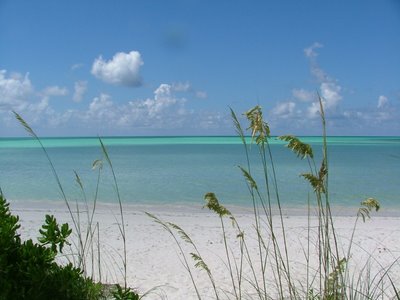
(photo - © J.Savage)
There will be another expedition to explore the shark diving potential of Eleuthera.
When this happens I will post the results, along with reviews of Stuart Cove’s shark dive sites and Valentines’ ‘Pinnacle’ and ‘Plateau’ dive sites.


0 Comments:
Post a Comment
<< Home